The Alkyl Acrylate Market is estimated to be valued at USD 10.6 billion in 2025 and is projected to reach USD 19.8 billion by 2035, registering a compound annual growth rate (CAGR) of 6.5% over the forecast period.
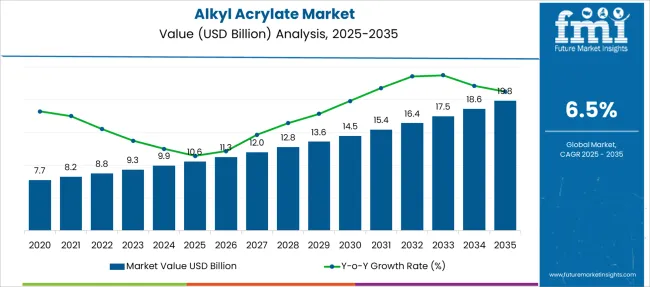
| Metric | Value |
|---|---|
| Alkyl Acrylate Market Estimated Value in (2025 E) | USD 10.6 billion |
| Alkyl Acrylate Market Forecast Value in (2035 F) | USD 19.8 billion |
| Forecast CAGR (2025 to 2035) | 6.5% |
The alkyl acrylate market is expanding steadily due to its broad applicability in personal care, adhesives, paints, and coatings, driven by rising demand for performance enhancing additives and functional polymers. Increased use in formulation chemistry for cosmetics and skincare has positioned alkyl acrylates as critical ingredients in texture modification, moisture retention, and active delivery.
Advancements in polymer synthesis and the growing emphasis on bio based and skin friendly formulations have further fueled innovation in this space. Environmental and regulatory factors are also shaping the market, as industries shift toward low volatile organic compound compositions and safe for skin alternatives.
The outlook remains optimistic as demand for multifunctional and high performance materials continues to rise across industrial and consumer applications, reinforcing the relevance of alkyl acrylates across diverse product lines.
The market is segmented by Chemical Groups, Product Types, Functions, and Applications and region. By Chemical Groups, the market is divided into Hydrophobic and Hydrophilic. In terms of Product Types, the market is classified into Methacrylate Crosspolymer, Butyl Acrylate, Ethyl Acrylate, Vinyl Isodecanoate Crosspolymer, Vinyl Neodecanoate Crosspolymer, Glycol Dimethacrylate Crosspolymer, Sodium Acrylates Crosspolymer-2, and Others. Based on Functions, the market is segmented into Absorbents, Emulsion Stabilizers, Viscosity Boosters, and Others. By Applications, the market is divided into Personal Care Products, Coatings, Textiles, Adhesives, Paper Manufacture, Pharmaceuticals, and Others. Regionally, the market is classified into North America, Latin America, Western Europe, Eastern Europe, Balkan & Baltic Countries, Russia & Belarus, Central Asia, East Asia, South Asia & Pacific, and the Middle East & Africa.
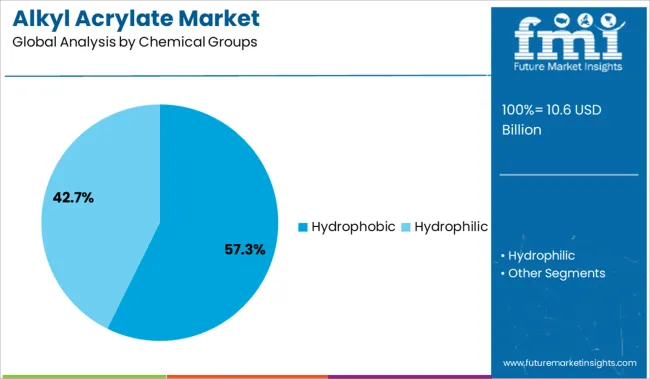
The hydrophobic segment is projected to hold 57.30% of the total market revenue by 2025 within the chemical groups category, making it the leading segment. This prominence is driven by its compatibility with water resistant and long wear formulations, particularly in personal care and industrial coatings.
Hydrophobic alkyl acrylates offer superior film forming, reduced tackiness, and enhanced product durability. Their ability to create barriers against moisture and environmental exposure has made them highly valued in both skincare products and protective surface applications.
Additionally, their stable interaction with other actives and excipients contributes to their dominance within this chemical group.
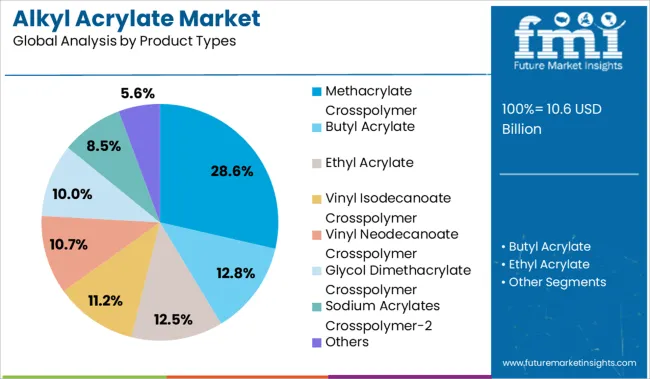
The methacrylate crosspolymer segment is expected to contribute 28.60% of market revenue by 2025 under the product types category, positioning it as a significant contributor. Its selection is based on excellent thickening, stabilizing, and emulsifying properties, particularly in cosmetics and personal care formulations.
Methacrylate crosspolymers improve spreadability, texture, and product stability, making them popular in gels, serums, and emulsions. The versatility of this polymer in forming transparent, high viscosity gels with smooth sensory attributes has made it a preferred choice among formulators.
This has reinforced its continued growth and relevance in advanced product formulations.

The absorbents segment is anticipated to account for 42.10% of overall market revenue by 2025 in the function category, making it the dominant function. The rising demand for oil control and sebum regulating formulations in skincare and cosmetics has elevated the role of absorbent alkyl acrylates.
These materials enhance product aesthetics by reducing greasiness and improving matte finishes. In addition, their functional integration in wound care, medical textiles, and hygiene products has further widened their application scope.
The ability to maintain efficacy without compromising on comfort or product performance positions absorbents as the leading function segment within the alkyl acrylate market.
Alkyl acrylate market is anticipated to witness high growth rate due to its properties such as high viscosity boosting, strong binding and emulsion stabilizing, which is most required in cosmetics products. Changing lifestyle of people coupled with increasing demand for anti-aging products is expected to propel the demand for alkyl acrylate, thus boosting the global alkyl acrylate market.
In addition to this, rapidly increasing demand for pharmaceuticals is also projected to augment the demand for alky acrylate over the forecast period. Increasing textile industry is also expected to fuel the demand for alkyl acrylates over the forecast period.
The major manufacturers in global alkyl acrylate market are focusing on developing new formulations that can maintain viscosity consistency at different temperatures. Furthermore, major companies have adopted the strategy of focussing on production capacity expansion.
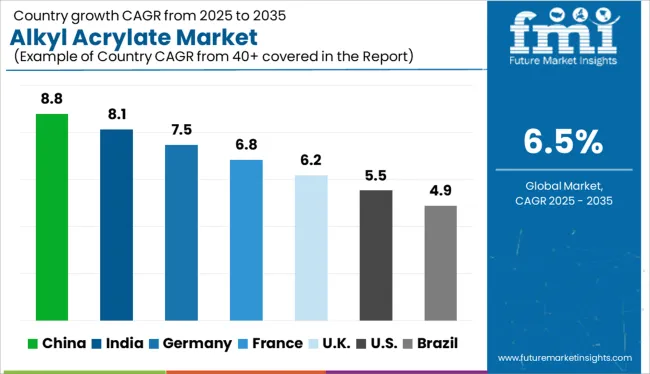
North America is expected to account for the largest market share in the global alkyl acrylate market over the forecast period. This is mainly attributed to the increasing demand for cosmetics in this region. The changing lifestyle of consumers coupled with increasing demand for anti-aging products is expected to boost the demand for alkyl acrylate market in this region.
Asia Pacific is expected to witness significantly higher growth rate in the global alkyl acrylate market over the forecast period. Europe is also expected to contribute a major share in the global alkyl acrylate market throughout the forecast period. Latin America and Middle East and Africa are also anticipated to exhibit relatively higher growth over the forecast period.
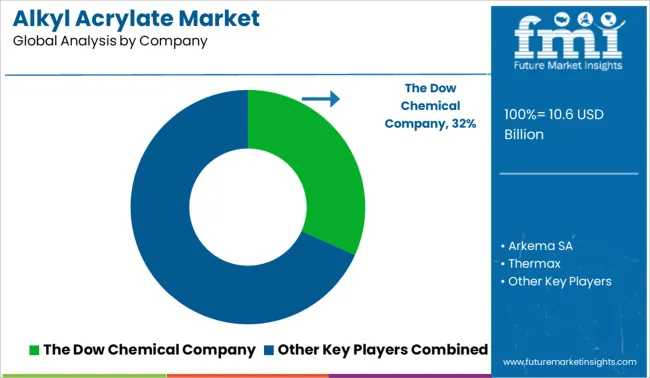
The competitive landscape for alkyl acrylate market is majorly marked by the presence of large players as well as small scale players. Some of the major players identified in the supply chain of alkyl acrylate market are The Dow Chemical Company, Arkema SA, Thermax, BASF SE, San Ester Corp., Anhui Newman Fine Chemicals Co., Ltd., and Osaka Organic Chemical Industry Ltd. among others.
The market research report presents a comprehensive assessment of the market and contains thoughtful insights, facts, historical data, and statistically supported and industry-validated market data. It also contains projections using a suitable set of assumptions and methodologies.
The research report provides analysis and information according to market segments such as geography,technology and applications.
The global alkyl acrylate market is estimated to be valued at USD 10.6 billion in 2025.
The market size for the alkyl acrylate market is projected to reach USD 19.8 billion by 2035.
The alkyl acrylate market is expected to grow at a 6.5% CAGR between 2025 and 2035.
The key product types in alkyl acrylate market are hydrophobic and hydrophilic.
In terms of product types, methacrylate crosspolymer segment to command 28.6% share in the alkyl acrylate market in 2025.






Our Research Products

The "Full Research Suite" delivers actionable market intel, deep dives on markets or technologies, so clients act faster, cut risk, and unlock growth.

The Leaderboard benchmarks and ranks top vendors, classifying them as Established Leaders, Leading Challengers, or Disruptors & Challengers.

Locates where complements amplify value and substitutes erode it, forecasting net impact by horizon

We deliver granular, decision-grade intel: market sizing, 5-year forecasts, pricing, adoption, usage, revenue, and operational KPIs—plus competitor tracking, regulation, and value chains—across 60 countries broadly.

Spot the shifts before they hit your P&L. We track inflection points, adoption curves, pricing moves, and ecosystem plays to show where demand is heading, why it is changing, and what to do next across high-growth markets and disruptive tech

Real-time reads of user behavior. We track shifting priorities, perceptions of today’s and next-gen services, and provider experience, then pace how fast tech moves from trial to adoption, blending buyer, consumer, and channel inputs with social signals (#WhySwitch, #UX).

Partner with our analyst team to build a custom report designed around your business priorities. From analysing market trends to assessing competitors or crafting bespoke datasets, we tailor insights to your needs.
Supplier Intelligence
Discovery & Profiling
Capacity & Footprint
Performance & Risk
Compliance & Governance
Commercial Readiness
Who Supplies Whom
Scorecards & Shortlists
Playbooks & Docs
Category Intelligence
Definition & Scope
Demand & Use Cases
Cost Drivers
Market Structure
Supply Chain Map
Trade & Policy
Operating Norms
Deliverables
Buyer Intelligence
Account Basics
Spend & Scope
Procurement Model
Vendor Requirements
Terms & Policies
Entry Strategy
Pain Points & Triggers
Outputs
Pricing Analysis
Benchmarks
Trends
Should-Cost
Indexation
Landed Cost
Commercial Terms
Deliverables
Brand Analysis
Positioning & Value Prop
Share & Presence
Customer Evidence
Go-to-Market
Digital & Reputation
Compliance & Trust
KPIs & Gaps
Outputs
Full Research Suite comprises of:
Market outlook & trends analysis
Interviews & case studies
Strategic recommendations
Vendor profiles & capabilities analysis
5-year forecasts
8 regions and 60+ country-level data splits
Market segment data splits
12 months of continuous data updates
DELIVERED AS:
PDF EXCEL ONLINE
Alkylation Melamine-Formaldehyde Resin for Coating Market Size and Share Forecast Outlook 2025 to 2035
Alkyl Polyglucosides Market Size and Share Forecast Outlook 2025 to 2035
Polyalkylene Glycol Market Growth - Trends & Forecast 2025 to 2035
Fluoroalkyl Based Coatings Market Size and Share Forecast Outlook 2025 to 2035
Linear Alkylbenzene Sulfonate (LAS) Market Size and Share Forecast Outlook 2025 to 2035
Zinc Dialkyldithiophosphates Additive Market Size and Share Forecast Outlook 2025 to 2035
Acrylate Market Size and Share Forecast Outlook 2025 to 2035
Acrylate Oligomer Market Growth - Trends & Forecast 2025 to 2035
Polyacrylate Rubber Market Analysis - Size, Share, and Forecast 2025 to 2035
Butyl Acrylate Market Size and Share Forecast Outlook 2025 to 2035
Isobornyl Acrylate Market Size and Share Forecast Outlook 2025 to 2035
Basic Methacrylate Copolymer Market Growth 2025 to 2035
Glycidyl Methacrylate Market Size and Share Forecast Outlook 2025 to 2035
Polymethyl Methacrylate (PMMA) Market Size and Share Forecast Outlook 2025 to 2035
1,6-Hexanediol Diacrylate Market Growth – Trends & Forecast 2024-2034
Synthetic And Bio Based PMMA Polymethyl Methacrylate Size Market Size and Share Forecast Outlook 2025 to 2035

Thank you!
You will receive an email from our Business Development Manager. Please be sure to check your SPAM/JUNK folder too.
Chat With
MaRIA